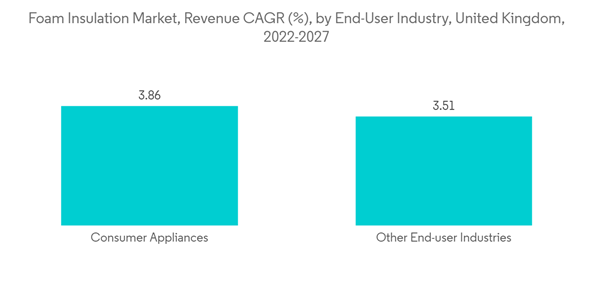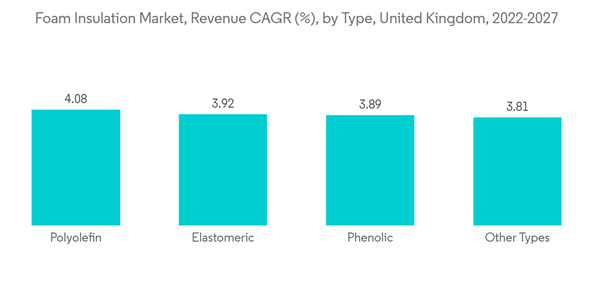The building and construction industry was one of the various industries affected by the outbreak of COVID-19. Continued lockdowns, various social distancing norms, and disruptions in the supply chain hindered the growth of the building and construction industries. Many projects were delayed due to a lack of labor, funding, and other causes. Also, some projects were completely shut down due to bankruptcy. The demand for foam insulation which is used extensively in the building and construction industry, was hampered during the same period.
With the industrial sector gradually returning to the pre-pandemic level of activity, the revival of the building and construction industry, along with transportation and consumer appliances, is expected to drive the demand for foam insulation in the market.
Key Highlights
- In the short term, the growing consumer appliances market is expected to drive the demand for foam insulation. In the consumer appliances segment, household appliances have seen an increase in demand, with consumers prioritizing home improvements by splurging money saved up from holidays and socializing.
- In the United Kingdom, if we see in the long term, the growing construction industry is expected to drive the demand for foam insulation during the forecast period.
- However, growing concerns regarding potential health issues arising from the use of isocyanates, such as MDI (methylene diphenyl diisocyanate), undergo reaction with polyols to form polyurethane, on the other hand could potentially hinder the demand for the studied market.
UK Foam Insulation Market Trends
Increasing Usage in the Building and Construction Segment
- With the increasing shift towards reducing greenhouse emissions and the overall carbon footprint, the government of the United Kingdom has been introducing schemes and insulation grants to help households reduce their electricity consumption and save up money on electricity bills.
- Post-pandemic, the building & construction industry has been gradually picking up pace. According to the Ministry of Housing, Communities and Local Government (UK), new housing unit construction in the United Kingdom increased to 42,350 units in the first quarter of 2022 from 41,600 units in the fourth quarter of 2021.
- The monthly construction output increased by 1.5% in volume terms in May 2022 compared to April 2022, stated the Office for National Statistics (UK). This is the seventh consecutive monthly growth following the upwardly revised increase to 0.3% in April 2022. May 2022 marked a record high in monthly-level terms (GBP 15,053 million) since last decade.
- With foam insulation being extensively used in the building and construction industry, the abovementioned factors are expected to drive market growth during the forecast period.
Higher demand for Polyurethane and Polyisocyanurate Foam
- Polyurethane Rigid Foam (PUR) and Polyisocyanurate Rigid Foam (PIR) are very close in chemical composition as both are polyurethane derivatives. PIR was created by improving PUR’s thermal stability and flame resistance.
- PUR insulation has high water resistance and can be injected into small spaces to create an air-tight seal. It can also provide an energy-efficient barrier if injected into wall cavities. According to the Insulation Manufacturer Association, PUR delivers “the best thermal performance of all practical fully cavity insulants.” It is also less expensive, making it ideal for continuous spraying for renovation purposes. Since PUR does not hold water, it is an ideal choice for flood-prone areas as it can minimize the damage through water impact in wall cavities.
- On the other hand, PIR can be typically cut into boards and used in insulated metal panels, wall cavities, and as insulated plasterboard. The thermal performance of PIR is higher when compared to its counterparts, so it requires only half the thickness of other mineral-based insulation products.
- The most advantageous factor of PIR is its high flame and smoke resistance compared to PUR products, which slows down the spread of flames and reduces the smoke emitted in case of a fire outbreak.
- As per the factors mentioned above, the demand for PUR and PIR insulation is expected to be relatively higher than its counterparts, thus driving the market growth.
UK Foam Insulation Market Competitor Analysis
The foam insulation market in the United Kingdom is consolidated in nature. Some of the major players in the market (in no particular order) include BASF SE, Covestro AG, Owens Corning, Saint-Gobain, Xtratherm Ltd., EcoTherm Insulation (UK) Limited, BAU UK Ltd, Ramsay Rubber Limited, JSJ Foam Insulation, Dow, Huntsman International LLC, Johns Manville, Knauf Insulation, Bauder Ltd., Kingspan Group, and others.Additional benefits of purchasing the report:
- The market estimate (ME) sheet in Excel format
- 3 months of analyst support
This product will be delivered within 2 business days.
Table of Contents
1 INTRODUCTION1.1 Study Assumptions
1.2 Scope of the Study
2 RESEARCH METHODOLOGY
3 EXECUTIVE SUMMARY
4 MARKET DYNAMICS
4.1 Drivers
4.1.1 Increasing Usage in the Building and Construction
4.1.2 Higher Demand for Polyurethane and Polyisocyanate Foam
4.2 Restraints
4.2.1 Growing Health Concerns
4.2.2 Challenges in Mortgaging or Reselling Houses with Foam Insulation
4.3 Industry Value-Chain Analysis
4.4 Porter's Five Forces Analysis
4.4.1 Bargaining Power of Suppliers
4.4.2 Bargaining Power of Buyers
4.4.3 Threat of New Entrants
4.4.4 Threat of Substitute Products and Services
4.4.5 Degree of Competition
5 MARKET SEGMENTATION
5.1 Types
5.1.1 Polystyrene
5.1.2 Polyurethane and Polyisocyanurate
5.1.3 Polyolefin
5.1.4 Elastomeric
5.1.5 Phenolic
5.1.6 Other Types
5.2 End-user Industry
5.2.1 Building and Construction
5.2.2 Transportation
5.2.3 Consumer Appliances
5.2.4 Other End-user Industries
6 COMPETITIVE LANDSCAPE
6.1 Mergers and Acquisitions, Joint Ventures, Collaborations, and Agreements
6.2 Market Share (%)**/Ranking Analysis
6.3 Strategies Adopted by Leading Players
6.4 Company Profiles
6.4.1 Armacell
6.4.2 BASF SE
6.4.3 BAU UK Ltd.
6.4.4 Bauder Ltd.
6.4.5 Covestro AG
6.4.6 Dow
6.4.7 EcoTherm Insulation (UK) Limited
6.4.8 Hunstman International LLC
6.4.9 Johns Manville
6.4.10 JSJ Foam Insulation
6.4.11 Kingspan Group
6.4.12 Knauf Insulation
6.4.13 Owens Corning
6.4.14 Ramsay Rubber
6.4.15 Recticel
6.4.16 Saint-Gobain
6.4.17 Xtratherm Ltd.
6.4.18 Zotefoams PLC
7 MARKET OPPORTUNITIES AND FUTURE TRENDS
7.1 Development of Eco-friendly Foam Insulation
Companies Mentioned (Partial List)
A selection of companies mentioned in this report includes, but is not limited to:
- Armacell
- BASF SE
- BAU UK Ltd.
- Bauder Ltd.
- Covestro AG
- Dow
- EcoTherm Insulation (UK) Limited
- Hunstman International LLC
- Johns Manville
- JSJ Foam Insulation
- Kingspan Group
- Knauf Insulation
- Owens Corning
- Ramsay Rubber
- Recticel
- Saint-Gobain
- Xtratherm Ltd.
- Zotefoams PLC










